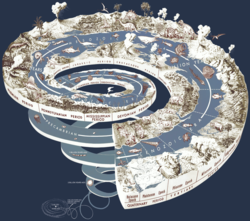
Back Geologiese tydskaal Afrikaans Geologische Zeitskala ALS مقياس زمني جيولوجي Arabic Escala temporal xeolóxica AST Geoxronoloji cədvəl Azerbaijani Геохронологик шкала Bashkir Геахраналагічная шкала Byelorussian Геохронологична скала Bulgarian भूबिज्ञानी समय पैमाना Bihari ভূতাত্ত্বিক সময় Bengali/Bangla

Geologic time scale uses the principles and techniques of geology to work out the geological history of the Earth.[1] It looks at the processes which change the Earth's surface and rocks under the surface.
Geologists use stratigraphy and paleontology to find out the sequence of the events, and show the plants and animals which lived at different times in the past. They worked out the sequence of rock layers. Then the discovery of radioactivity and the invention of radiometric dating techniques gave a way to get the ages of the layers (strata).
We now know the timing of important events that have happened during the history of Earth. The Earth is about 4.567 billion (4,567 million) years old. The geological or deep time of Earth's past has been organized into various units. Boundaries on the time scale are usually marked by major geological or palaeontological events, such as mass extinctions. For example, the boundary between the Cretaceous period and the Palaeogene period is defined by the Cretaceous–Tertiary extinction event. This marked the end of the dinosaurs and of many marine species.
Prospecting for energy sources and valuable minerals depends on understanding the geological history of an area. Such knowledge can also help lessen the hazards of earthquakes and volcanoes.
- ↑ Levin, Harold 2003. The Earth through time, Hoboken, New Jersey: Wiley, p.2